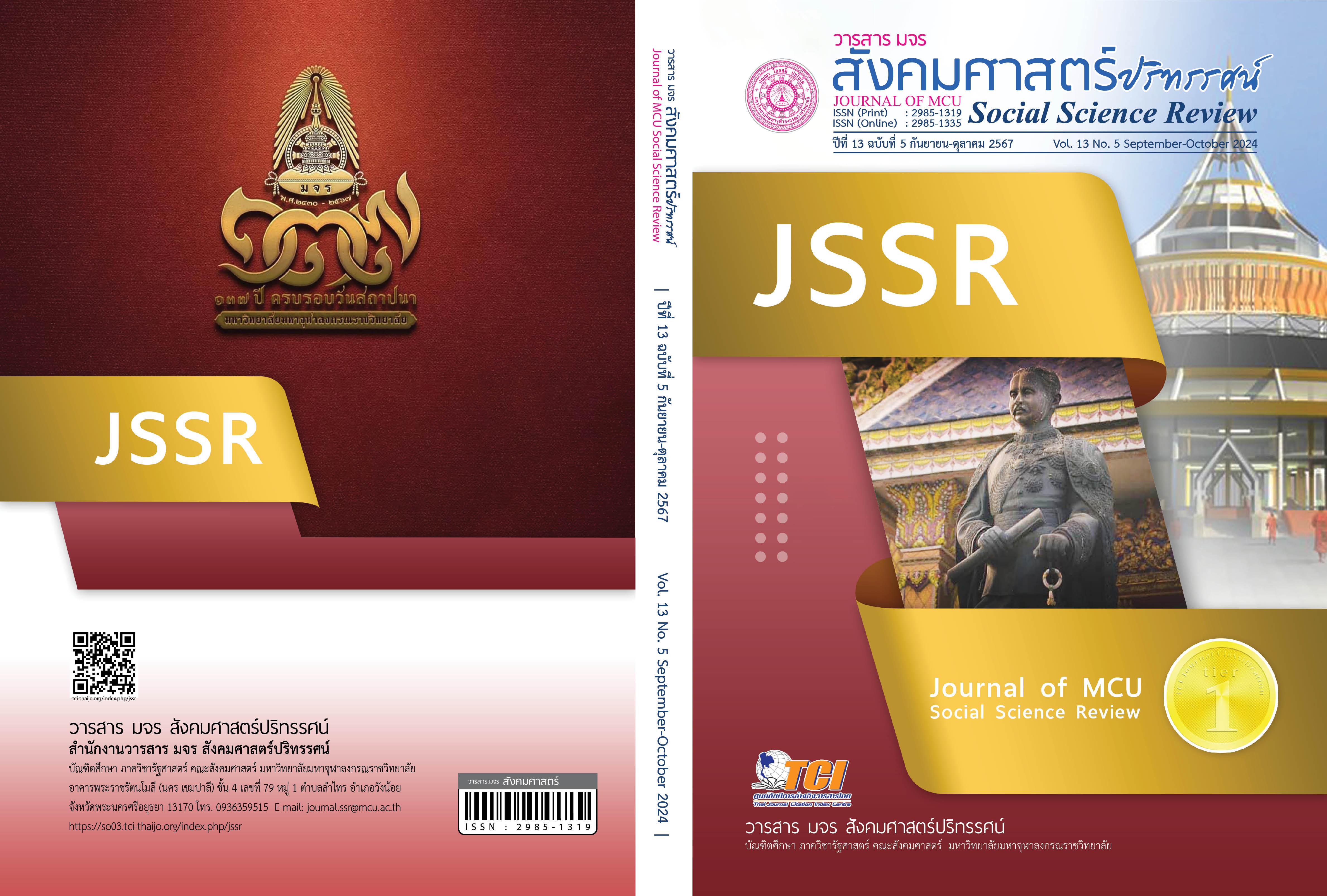กระบวนการเรียนรู้นอกระบบโรงเรียนและตามอัธยาศัยสู่การเป็นนักเขียนการ์ตูนมืออาชีพ : กรณีศึกษานายอนันท์ ฐิตาคม
คำสำคัญ:
แนวทางพัฒนานักเขียนการ์ตูน, กระบวนการเรียนรู้นอกระบบโรงเรียน, กระบวนการเรียนรู้ตามอัธยาศัยบทคัดย่อ
บทความวิจัยนี้มีวัตถุประสงค์ 1. วิเคราะห์เส้นทางและกระบวนการเรียนรู้นอกระบบโรงเรียนและตามอัธยาศัยสู่การเป็นนักเขียนการ์ตูนมืออาชีพ 2. จัดทำแนวทางพัฒนานักเขียนการ์ตูนมืออาชีพโดยใช้กระบวนการเรียนรู้นอกระบบโรงเรียนและตามอัธยาศัยจากกรณีศึกษานายอนันท์ ฐิตาคม เป็นการวิจัยเชิงคุณภาพ ผู้ให้ข้อมูลหลักประกอบด้วยนายอนันท์ ฐิตาคม และบุคคลใกล้ชิด ด้วยการคัดเลือกแบบเจาะจง เครื่องมือที่ใช้ในการวิจัย คือ การสัมภาษณ์เชิงลึก แล้วนำมาวิเคราะห์ข้อมูลด้วยวิธีการวิเคราะห์เนื้อหา
ผลการวิจัยพบว่า 1. เส้นทางและกระบวนการเรียนรู้นอกระบบโรงเรียนและตามอัธยาศัยสู่การเป็นนักเขียนการ์ตูนมืออาชีพ ประกอบไปด้วย เหตุการณ์ที่เกิดจากภายในตนเอง เหตุการณ์ภายนอกต่าง ๆ ที่ส่งผลต่อการตัดสินใจในการเป็นนักเขียนการ์ตูน 2. แนวทางพัฒนานักเขียนการ์ตูนมืออาชีพโดยใช้กระบวนการเรียนรู้นอกระบบโรงเรียนและตามอัธยาศัย 10 ขั้นตอน ได้แก่ 1. ผู้เรียนชื่นชอบการ์ตูน 2. การสร้างพื้นฐานในการเขียนการ์ตูน 3. การหาความรู้เพื่อเพิ่มทักษะของตนเอง 4. การนำความรู้ที่ได้รับมาฝึกฝน และปรับปรุงแก้ไข 5. การสร้างสรรค้ผลงาน 6. การตรวจสอบผลงานที่สร้างสรรค์ 7. การปรับปรุงผลงาน 8. การหาที่เผยแพร่ผลงาน 9. ผลงานได้รับหรือไม่ได้รับการยอมรับ 10. นักเขียนการ์ตูนที่ประสบความสำเร็จ
เอกสารอ้างอิง
โกวิท วรพิพัฒน์. (2544). ปรัชญาคิดเป็น. กรุงเทพฯ: โรงพิมพ์อักษรไทย.
จามรี ศิริภัทร. (2556). การออกแบบสื่อกราฟิกเพื่อการศึกษา= Graphic media design for educational. กรุงเทพฯ: สำนักพิมพ์มหาวิทยาลัยรามคำแหง.
ชัยฤทธิ์ โพธิสุวรรณ. (2541). การเรียนรู้จากประสบการณ์ การเรียนรู้โดยการชี้นำตนเองและการสร้างสรรค์ความรู้ : มุมมองทางการศึกษานอกระบบ. วารสารศึกษาศาสตร์ปริทัศน์, 15(2), 9-19.
พัชรี มะแสงสม. (2544). ปัจจัยบางประการที่สัมพันธ์กับความพร้อมในการเรียนรู้ด้วยตนเอง (วิทยานิพนธ์การศึกษามหาบัณฑิต สาขาวิชาการวิจัยและสถิติทางการศึกษา). กรุงเทพฯ: มหาวิทยาลัยศรีนครินทรวิโรฒ.
ระวี จูฑศฤงค์. (2564). มโนทัศน์ (Concept) ของการศึกษานอกระบบโรงเรียนและการศึกษาตามอัธยาศัย เหมือนหรือแตกต่างกันอย่างไร. สืบค้น 20 มกราคม 2565, จาก https://shorturl.asia/Wpo3U
วรรัตน์ ปทุมเจริญวัฒนา. (2561). การศึกษาตามอัธยาศัย. กรุงเทพฯ: โรงพิมพ์จุฬาลงกรณ์มหาวิทยาลัย.
วรรัตน์ อภินันท์กุล. (2551). การจัดกิจกรรมการเรียนรู้ทางการศึกษานอกระบบโรงเรียนและการศึกษาตามอัธยาศัยในปัจจุบัน. วารสารครุศาสตร์, 36(2), 15-28.
วัลลภ แม่นยำ. (2539). เทคนิคการวาดและขายการ์ตูนอย่างมืออาชีพ = How to draw and sell cartoons. กรุงเทพฯ: ซีเอ็ดยูเคชั่น.
อัญชลี ธรรมะวิธีกุล. (2551). หลักการของการจัดการศึกษานอกระบบ และปรัชญาการศึกษาที่เกี่ยวกับการศึกษานอกระบบ. สืบค้น 18 ตุลาคม 2565, จาก https://shorturl.asia/JblOr
อุดม เชยกีวงศ์. (2544). แนวทางการบริหารและการจัดการ : การศึกษานอกระบบและการศึกษาตามอัธยาศัย ตามแนวทางพระรบัญญัติการศึกษาแห่งชาติ พ.ศ. 2542. กรุงเทพฯ: บรรณกิจ.
อุ่นตา นพคุณ. (2523). การศึกษานอกระบบโรงเรียน. กรุงเทพฯ: จุฬาลงกรณ์มหาวิทยาลัย.
Mezirow, J. (2012). Learning to think like an adult: Core concepts of transformation theory. In Taylor, E. and Cranton, P. (eds), The Handbook of Transformative Learning: Theory, Research and Practise. (pp. 73-96). San Francisco, CA: Jossey-Bass.
Revans, R. (1977). Action Learning: Its Origins and Nature. In Action Learning in Practice. (3rd ed.). UK: Gower Publishing, Ltd.
ดาวน์โหลด
เผยแพร่แล้ว
รูปแบบการอ้างอิง
ฉบับ
ประเภทบทความ
สัญญาอนุญาต
ลิขสิทธิ์ (c) 2024 วารสาร มจร สังคมศาสตร์ปริทรรศน์

อนุญาตภายใต้เงื่อนไข Creative Commons Attribution-NonCommercial-NoDerivatives 4.0 International License.
เพื่อให้เป็นไปตามกฎหมายลิขสิทธิ์ ผู้นิพนธ์ทุกท่านต้องลงลายมือชื่อในแบบฟอร์มใบมอบลิขสิทธิ์บทความให้แก่วารสารฯ พร้อมกับบทความต้นฉบับที่ได้แก้ไขครั้งสุดท้าย นอกจากนี้ ผู้นิพนธ์ทุกท่านต้องยืนยันว่าบทความต้นฉบับที่ส่งมาตีพิมพ์นั้น ได้ส่งมาตีพิมพ์เฉพาะในวารสาร มจร สังคมศาสตร์ปริทรรศน์ เพียงแห่งเดียวเท่านั้น หากมีการใช้ภาพหรือตารางหรือเนื้อหาอื่นๆ ของผู้นิพนธ์อื่นที่ปรากฏในสิ่งตีพิมพ์อื่นมาแล้ว ผู้นิพนธ์ต้องขออนุญาตเจ้าของลิขสิทธิ์ก่อน พร้อมทั้งแสดงหนังสือที่ได้รับการยินยอมต่อบรรณาธิการ ก่อนที่บทความจะได้รับการตีพิมพ์ หากไม่เป็นไปตามข้อกำหนดเบื้องต้น ทางวารสารจะถอดบทความของท่านออกโดยไม่มีข้อยกเว้นใดๆ ทั้งสิ้น





